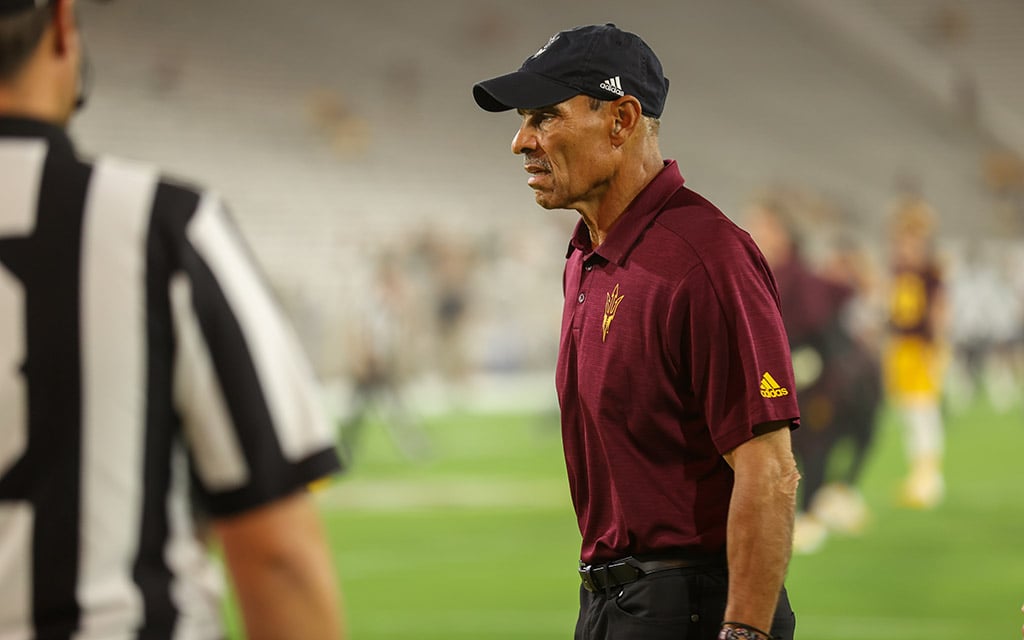
Infractions committed during the Herm Edwards era translates to significant penalties for Arizona State football. (File photo by Mary Grace Grabill/Cronkite News)
TEMPE – As Arizona State prepares to shift from the Pac-12 Conference to the Big 12, it will do so with significant baggage.
On Friday, the NCAA Infractions Committee announced the athletic department faces four years of probation, scholarship reductions and recruiting restrictions for violations that occurred during Herm Edwards’ tenure as football coach.
The Level I violations also include fines, a 2023 season self-imposed football postseason ban, a vacation of records for contests that ineligible student-athletes competed in and the dissociation with an involved booster for five years.
The news broke on the day after quarterback Jaden Rashada announced he was entering the transfer portal and on the same day of reports that top wide receiver Elijah Badger was leaving the team.
The NCAA also reported that four former staffers received show-cause orders ranging from three to 10 years, consistent with the Level I classifications of the violations.
In the NCAA rulebook, Level I violations are the most serious out of the three categories and are described as “violations that seriously undermine or threaten the integrity of college sports.”
By comparison, Level III is designed to punish violations that are “isolated or limited in nature” and “(p)rovide no more than a minimal recruiting, competitive or other advantage.”
The violations described in the NCAA statement include impermissible in-person recruiting contacts while the state of college athletics was experiencing the COVID-19 dead period. It also mentioned recruiting inducements, impermissible tryouts and tampering.
The resolution highlighted that the violations “demonstrated unethical conduct by involved individuals and a head coach responsibility violation” that refers to former Sun Devils football coach Herm Edwards, who has since returned to an analyst position at ESPN.
The ASU athletic department is now tied with Southern Methodist University for the most major infractions in the NCAA with 10, according to the NCAA database.
Other schools have received punishments for involvement in illicit recruitment procedures during the COVID-19 dead period. The NCAA released a similar punishment statement as recently as April 16 directed toward Michigan.
Using some of the same language for Michigan, the violations that were agreed upon include “impermissible in-person recruiting contacts during a COVID-19 dead period, impermissible tryouts, and the program exceeding the number of allowed countable coaches when noncoaching staff members engaged in on- and off-field coaching activities.”
However, Michigan will receive only three years of probation as opposed to ASU’s four, in addition to a fine and recruiting restrictions. The five individuals who participated agreed to one-year show-cause orders which are related to Level-II Standard and Level II-Mitigated classifications of the violations, significantly less harsh than ASU.
All eight of ASU’s 2021 football victories would be vacated in addition to two wins from the 2022 season, Chris Karpman of Sun Devil Source reported.
The university was applauded for its willing assistance during the NCAA investigation.
“Arizona State’s cooperation throughout the investigation and processing of this case was exemplary, and the cooperation began with the leadership shown by (ASU president Michael Crow),” said Jason Leonard, executive director of athletics compliance at Oklahoma and chief hearing officer for the Committee on Infractions.
Full findings have not been released since the investigation is ongoing. With remaining ASU staff members who did not agree to the negotiated resolution going through a separate process, the investigation could continue for several more months.
The restraints on ASU’s recruiting ability as a result of the violations could greatly affect the school as it transitions into a new conference.
ASU already ranks second to last among Pac-12 conference teams in recruitment spending for all men sports, according to the most recent U.S. Department of Education’s Equity in Athletics database numbers. While Colorado spent $1.21 million, ASU was just slightly higher at $1.35 million. Those numbers are close to just a third of USC’s recruiting budget of $3.65 million during that same time.
